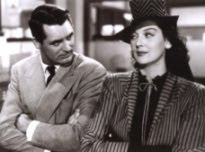Garner and his co-star Audrey Hepburn, decidedly not in character for their roles in William Wyler's "The Children's Hour"
James Garner is one of those effortless actors perennially taken for granted during the years, the decades, that he performed in film after film, genre after genre. When he died on July 19, at age 86, one could sense the collective sigh, "Oh, yeah, he was great!," tinged with a little regret.
He wasn't appreciated enough as an actor and one could take from his easy-going manner that he really didn't care about that. In his off-screen life, he had accomplished the things in life that really matter. Jim - it seems right to call him that - was a former Marine who won two Purple Hearts during the Korean War and he was married to his wife Lois for 58 years. Fifty-eight years. And without a single hint of scandal.
As a leading man, he had it all. A model leading man: Tall, dark and handsome. Based on looks alone, he should have been the kind of guy easy to dislike, if it weren't for his easy accessibility and, yes, likability.
Garner and his "Great Escape"co-star, Steve McQueen, were both popular TV actors who managed to break into movies at a time when TV actors had scant credibility/bankability. Garner was a contract Warner Bros. TV player and his boss, Jack Warner, was known for drawing a clear line that divided his feature film players from the TV employees in his stable.
The latter rarely crossed over. But Warner put Garner in "Sayonara," "Darby's Rangers" and "Cash McCall" before lending him out to the Mirisch Bros. for his first serious role in William Wyler's "The Children's Hour" (1961). In direct contrast, Garner followed that with a game, spirited turn in the wry Kim Novak comedy, "Boys' Night Out" (1962) for MGM.
Showing his antic side in Norman Jewison's delicious "The Thrill of It All"
Then came 1963, during which he starred in no fewer than four films - the aforementioned "The Great Escape," by John Sturges, Arthur Hiller's "The Wheeler Dealers" and two with Doris Day, Norman Jewison's "The Thrill of It All" and Michael Gordon's "Move Over, Darling." A year later came the Paddy Chayefsky-scripted "The Americanization of Emily," also directed by Hiller. And Jim Garner was no longer just a "TV actor."
Scores of films of varying quality followed, both the known -"Grand Prix," "Victor/Victoria," "Marlow," "Support Your Local Sheriff" and "Skin Game" - and the unknown -"The Pink Jungle," "The Art of Love," A Man Could Get Killed" and "How Sweet It Is," with Debbie Reynolds. (That's Jim with Debbie in the photo below.)
Four of of his more interesting efforts were George Seaton's tricky "36 Hours" (1965), based on a Roald Dahl story and co-staarring Eva Marie Saint and Rod Taylor; Delbert Mann's "Mister Buddwing" (1966) with a script by Dale Wasserman (author of the play "One Flew Over the Cuckoo's Nest") and which Mann shot as a New York indie (despite the MGM imprimatur); his Oscar-nominated role in Martin Ritt's "Murphy's Romance" (1989) and Robert Benton's nifty murder-mix-up, "Twilight" (1980, co-starring Paul Newman, Gene Hackman and Susan Sarandon.
I also have a very soft spot for "They Only Kill Their Masters" (1972), a playful whodunit romp directed by the ever-underrated James Goldstone and co-starring Katharine Ross and, in her last major role, June Allyson.
Turner Classic Movies is devoting its entire schedule today to Jim, starting ... now.
Garner and Rod Taylor doing very well by author Roald Dahl in "36 Hours"


































